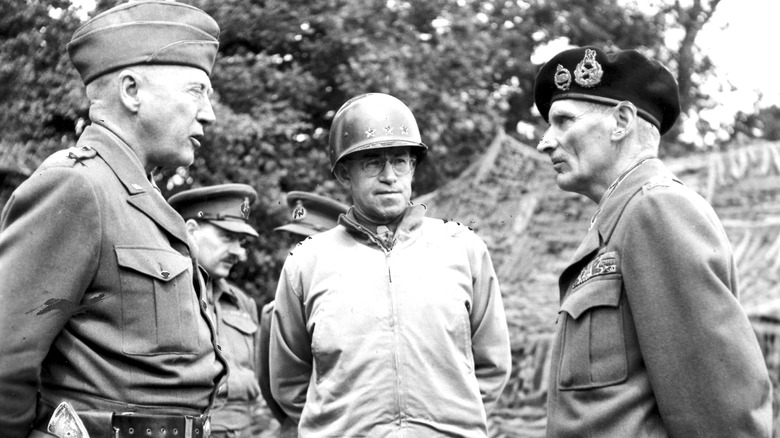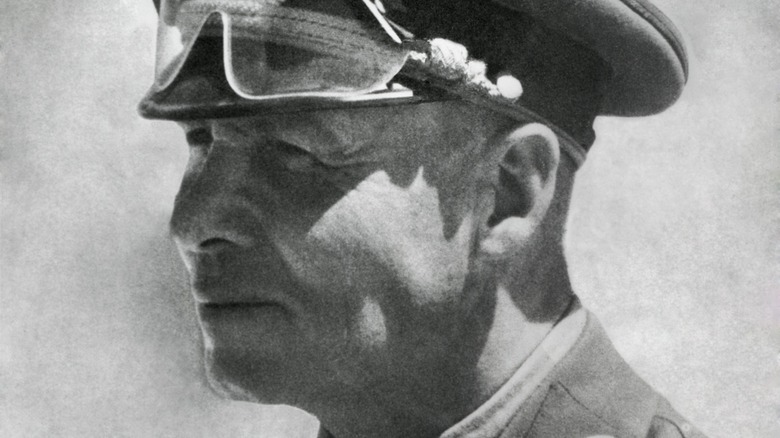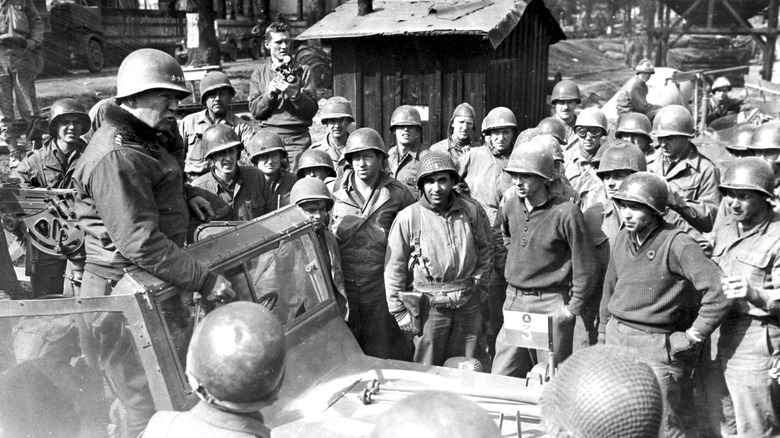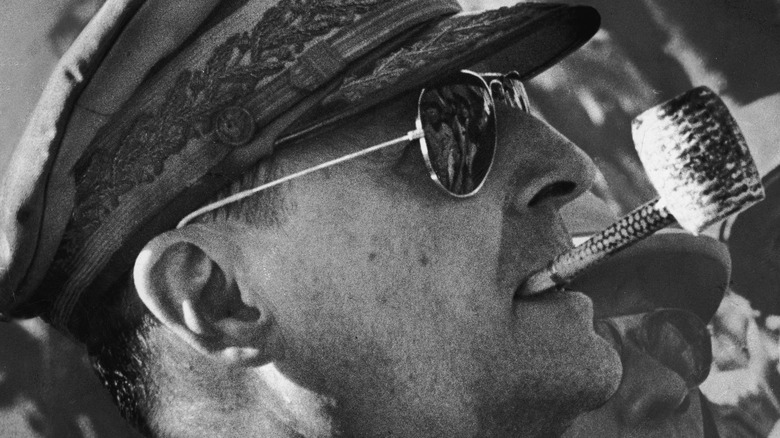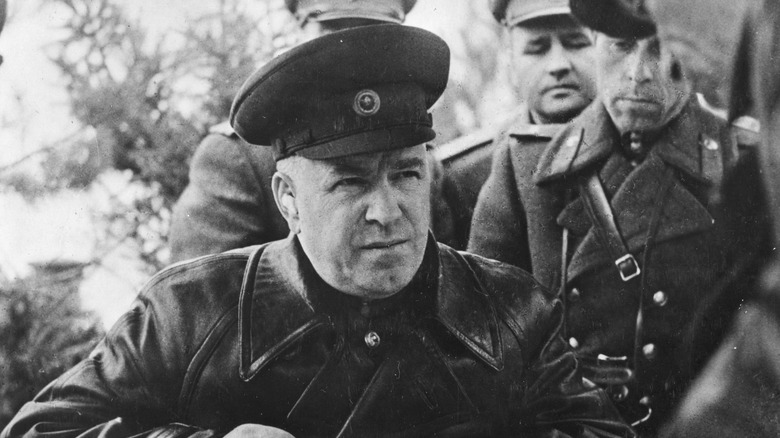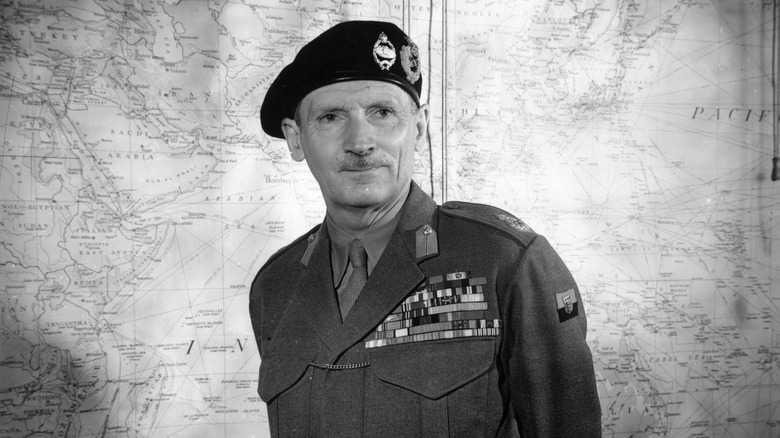What Happened To The Bodies Of These Notable WWII Generals?
World War II saw several men rise to the fore to command the fighting forces in history's bloodiest and most far-reaching conflict. The exploits of military leaders like the U.S. Generals George C. Patton and Douglas MacArthur, Germany's Field Marshal Erwin Rommel, Britain's Field Marshal Bernard Montgomery, and the Soviet's Marshal Georgy Zhukov have become legendary. Their deaths and what became of their mortal remains are nearly as interesting as the celebrated lives they led.
All five of these military leaders managed to dodge enemy bullets, but in the case of Rommel, he was forced into dying by suicide before the war's end by Adolph Hitler and had his body cremated. The other four survived to see Allied victory. Patton died from injuries sustained in a car accident just months after the end of the war and was buried with his fellow soldiers at a war cemetery in Luxembourg. The final three — MacArthur, Zhukov, and Montgomery — died in old age. Montgomery, the last to die in 1976, is buried in a rural English cemetery while MacArthur and Zhukov's final resting places are much more imposing.
Erwin Rommel's end
Field Marshal Erwin Rommel was known as "the Desert Fox" for his bold command of Germany's Afrika Korps during the North African campaign from 1941 to 1943. Then, in July 1944, British fighter planes attacked Rommel's car in France, wounding him. He returned to Germany to recover. After a failed assassination attempt on Adolph Hitler by a group of conspirators with ties to Rommel, Hitler decided the general had to go. But Rommel was hugely popular at home, which meant Hitler had to tread lightly. On October 14, 1944, Hitler sent two generals to Herlingen, a suburb of Ulm, where Rommel was recovering, and gave him the choice of dying by suicide or facing a show trial, which would result in his execution.
In order to save his family, Rommel took cyanide. The Nazis lied about the general's death, blaming it on complications from his injuries. After his death, Hitler, in an attempt to unite the nation, held a massive state funeral. They cremated his body and he is buried in Herrlingen, not far from where he died. The 2019 book "General Field Marshal Erwin Rommel: Myth of his Cremation in Germany. A Shocking Revelation" later claimed that Rommel hadn't died in 1944, but instead had fled Germany under an assumed name, had a secret family, and died in Walawi, in East Africa, in 1987 at 96 years old.
Patton is buried alongside his troops
General George S. Patton lay dying in a hospital in Heidelberg, Germany. The four-star U.S. general known as "Old Blood and Guts" to his soldiers, had faced long odds and tough situations from North Africa to Normandy, France, in his long military career. He'd helped save the day in one of the most underappreciated allied victories of the war during the Battle of the Bulge. In December 1944, he and the Third Army smashed the German lines to relieve American troops in Bastogne, Belgium, which was the key to victory. But now he lay in a hospital bed paralyzed from the neck down following a car accident in Manheim, Germany, less than four months after the end of World War II. On Dec. 21, 1945, a blood clot reached the 60-year-old general's heart causing an embolism, and he succumbed.
There was some question as to where Patton's body would end up. His widow, Beatrice, wanted to bury him in Massachusetts; the French government offered to bury him in Napoleon's grave — a great honor — but in the end, Patton got his wish and was buried with many of the troops who had served under him at the Battle of the Bulge. After lying in state in Heidelberg, a procession carrying Patton's flag-draped gunmetal casket brought it to the train station. After Patton's body arrived in Luxembourg, they buried him at the American Cemetery in a grave dug by German prisoners of war.
MacArthur's memorial
The tragic death of General Douglas MacArthur came at the end of a slow decline. He had guided the Allied victory over Japan during World War II. Five years later, he commanded the United Nations troops in Korea until President Harry S. Truman relieved him of his command for insubordination in April 1951. Even so, at the time of his death on April 6, 1964, he was the country's senior five-star general. For five weeks he lay in bed at Walter Reed Army Medical Center in Bethesda, Maryland. He underwent three operations and numerous blood transfusions before dying of kidney and liver failure after falling into a coma. He was 84.
His body lay in state in Manhattan where he and his wife Jean had been living since 1951 and then in Washington, D.C. MacArthur was then interred in Norfolk, Virginia. Three years before his death, the city had offered to create a MacArthur memorial and museum. The general agreed but with the stipulation that he and his wife Jean could be buried in the rotunda. When he died three years later, MacArthur was buried inside the memorial in the city he called his "spiritual home" per The Valley Evening Monitor.
Marshal Georgy Zhukov's Kremlin resting place
In Marshal Georgy Zhukov's long life, he'd risen to the top rank of the Soviet army as its chief of staff, served as a Marshal of the Soviet Union, oversaw the defense of Moscow, Stalingrad, and Leningrad, and had his hand in a string of major battles and personally led the final assault on Berlin. Today he's considered the most important Soviet commander of World War II.
But in the Soviet Union during the 1940s and 1950s, power and popularity could rise and fall with the whims of Joseph Stalin. The Soviet leader, wary of any potential threats, stripped Zhukov of his posts after the general had helped save his nation. After Stalin's death, the general's status continued to waver and by the time of his death in 1974, he had again been relegated to the sidelines. In 1974, Zhukov suffered a series of strokes and died. He had wanted a Russian Orthodox funeral and burial but instead, the Soviets cremated his body and interred his remains at the Kremlin Wall Necropolis, where the state buried its most venerated heroes.
General Montgomery's rural grave
British Field Marshal Bernard Montgomery, 88 and bedridden, finally succumbed on March 24, 1976, dying in his sleep far from the battlefields of World War II where he'd made his reputation for being a cautious but tenacious general. He had outlived many of the other great World War II commanders, such as General Erwin Rommel who he'd beaten twice in North Africa, including in the second battle of El Alamein, one of the most important battles of World War II in late 1942. He also outlived many of the U.S. generals he'd often wrangled with over tactics, including General George Patton, who he disagreed with during the invasions of Sicily and Salerno in 1943.
After the war, the British Crown made Montgomery a Knight of the Garter. Because of this, he was given an elaborate funeral with full military honors at St. George's Chapel at Windsor Castle. A week after his death, amid drum beats and cannon fire, six black horses pulled a gun carriage with his casket to the church, according to The Roanoke Times. The famous beret he always wore sat atop the flag-draped casket. Thousands of mourners, including members of the Royal Family, were there to pay their final respects. Afterward, they buried him under an ancient yew tree in a rural cemetery in Binsted attached to the Anglican church that Montgomery — a devout Christian — attended.
